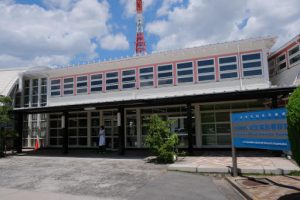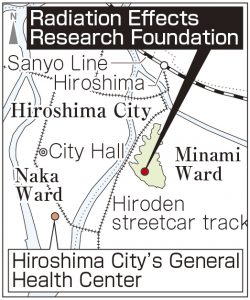Report says RERF move to Hiroshima City’s General Health Center is viable
Jun. 25, 2019
by Kyosuke Mizukawa, Staff Writer
On June 24, details were learned regarding the report on the investigation involving the relocation of the Radiation Effects Research Foundation (RERF), located in Minami Ward, Hiroshima. RERF, which is jointly funded and managed by the governments of Japan and the United States, carried out this investigation in fiscal 2018. The report has concluded that moving the organization into the City of Hiroshima’s General Health Center in Naka Ward is a viable idea, given such factors as the availability of space for installing large pieces of equipment. The total costs for the relocation have been estimated at around 6.1 billion yen. RERF will now study this possible move to the General Health Center more closely. At the same time, the focus will turn to whether Japan and the United States are able to come to an agreement with regard to covering the costs of the relocation.
To carry out the investigation, the Japanese government allocated funds for this effort in the initial budget for fiscal 2018. RERF then outsourced the project to the Shimadzu Rika Corporation, a firm based in Tokyo that specializes in providing support for the relocation of research facilities. The investigation sought to confirm whether the General Health Center would meet the requirements for the relocation site and if there might be other candidate sites for this move.
The report of the investigation states that RERF must be relocated or newly constructed after the organization is dismantled, considering that the current facility was built roughly 70 years ago and has deteriorated over time. It says that efforts were made to find other candidate sites that could meet seven criteria for relocation, including the possibility of relocating within a few years, the availability of a large space for installing sizable cooling units to store blood samples collected from A-bomb survivors and other items, and suitable security requirements. However, the investigation was unable to find any facilities, apart from the General Health Center, that met all the criteria for the relocation.
In addition, the report provided an estimate of the relocation costs if RERF were to move into the General Health Center. The rough calculation is that about 4.14 billion yen would be needed to renovate the health center plus another 950 million yen to transport and adjust RERF’s equipment and other devices, totaling 6.1 billion yen, which includes the cost of dismantling the current facility.
RERF will consider this report about relocating its current functions, as well as its vision for future research, and examine whether or not any additional equipment is required, then make a final decision about the move. According to RERF, when the organization’s council met in the United States on June 20 and 21, the council members also encouraged RERF to take concrete steps to study this possible relocation.
With regard to RERF’s current location, the Atomic Bomb Casualty Commission (ABCC), the forerunner of RERF, was moved to Hijiyama Park in 1950. The City of Hiroshima has long considered this location to be problematic, arguing that “The city was against the move, but it was pushed forward by the postwar occupation forces.” With A-bomb survivors’ groups in Hiroshima also calling for the organization to be relocated to a different site, this issue has been one of the biggest concerns through the postwar period for the A-bombed city’s development.
Meanwhile, the City of Hiroshima has assessed RERF’s research endeavors and proposed that the organization be moved into the General Health Center, in line with guidance from the Japanese government, which has indicated that constructing a new building for this relocation would be difficult because of the cost. The city has announced its intention to reorganize the Hijiyama Hill Park area into the “Hill for Peace,” which would include the site where RERF is currently located. RERF will soon discuss the results of the investigation with city officials.
Keywords
Radiation Effects Research Foundation (RERF)
RERF was originally established in 1947 as the Atomic Bomb Casualty Commission (ABCC) with the aim of investigating the long-term effects of radiation from the atomic bomb. Later, based in Hiroshima and Nagasaki, the organization began a large-scale survey of about 120,000 A-bomb survivors. Since its reorganization into RERF in 1975, the organization has been jointly funded and managed by the governments of Japan and the United States, and has been working to analyze the correlation between the incidence of cancer in A-bomb survivors, their mortality rate from cancer, and the amount of radiation they were exposed to at the time of the atomic bombing. RERF has also been pursuing research projects related to second-generation A-bomb survivors and those who experienced the atomic bombing while in their mother’s womb.
(Originally published on June 25, 2019)
On June 24, details were learned regarding the report on the investigation involving the relocation of the Radiation Effects Research Foundation (RERF), located in Minami Ward, Hiroshima. RERF, which is jointly funded and managed by the governments of Japan and the United States, carried out this investigation in fiscal 2018. The report has concluded that moving the organization into the City of Hiroshima’s General Health Center in Naka Ward is a viable idea, given such factors as the availability of space for installing large pieces of equipment. The total costs for the relocation have been estimated at around 6.1 billion yen. RERF will now study this possible move to the General Health Center more closely. At the same time, the focus will turn to whether Japan and the United States are able to come to an agreement with regard to covering the costs of the relocation.
To carry out the investigation, the Japanese government allocated funds for this effort in the initial budget for fiscal 2018. RERF then outsourced the project to the Shimadzu Rika Corporation, a firm based in Tokyo that specializes in providing support for the relocation of research facilities. The investigation sought to confirm whether the General Health Center would meet the requirements for the relocation site and if there might be other candidate sites for this move.
The report of the investigation states that RERF must be relocated or newly constructed after the organization is dismantled, considering that the current facility was built roughly 70 years ago and has deteriorated over time. It says that efforts were made to find other candidate sites that could meet seven criteria for relocation, including the possibility of relocating within a few years, the availability of a large space for installing sizable cooling units to store blood samples collected from A-bomb survivors and other items, and suitable security requirements. However, the investigation was unable to find any facilities, apart from the General Health Center, that met all the criteria for the relocation.
In addition, the report provided an estimate of the relocation costs if RERF were to move into the General Health Center. The rough calculation is that about 4.14 billion yen would be needed to renovate the health center plus another 950 million yen to transport and adjust RERF’s equipment and other devices, totaling 6.1 billion yen, which includes the cost of dismantling the current facility.
RERF will consider this report about relocating its current functions, as well as its vision for future research, and examine whether or not any additional equipment is required, then make a final decision about the move. According to RERF, when the organization’s council met in the United States on June 20 and 21, the council members also encouraged RERF to take concrete steps to study this possible relocation.
With regard to RERF’s current location, the Atomic Bomb Casualty Commission (ABCC), the forerunner of RERF, was moved to Hijiyama Park in 1950. The City of Hiroshima has long considered this location to be problematic, arguing that “The city was against the move, but it was pushed forward by the postwar occupation forces.” With A-bomb survivors’ groups in Hiroshima also calling for the organization to be relocated to a different site, this issue has been one of the biggest concerns through the postwar period for the A-bombed city’s development.
Meanwhile, the City of Hiroshima has assessed RERF’s research endeavors and proposed that the organization be moved into the General Health Center, in line with guidance from the Japanese government, which has indicated that constructing a new building for this relocation would be difficult because of the cost. The city has announced its intention to reorganize the Hijiyama Hill Park area into the “Hill for Peace,” which would include the site where RERF is currently located. RERF will soon discuss the results of the investigation with city officials.
Keywords
Radiation Effects Research Foundation (RERF)
RERF was originally established in 1947 as the Atomic Bomb Casualty Commission (ABCC) with the aim of investigating the long-term effects of radiation from the atomic bomb. Later, based in Hiroshima and Nagasaki, the organization began a large-scale survey of about 120,000 A-bomb survivors. Since its reorganization into RERF in 1975, the organization has been jointly funded and managed by the governments of Japan and the United States, and has been working to analyze the correlation between the incidence of cancer in A-bomb survivors, their mortality rate from cancer, and the amount of radiation they were exposed to at the time of the atomic bombing. RERF has also been pursuing research projects related to second-generation A-bomb survivors and those who experienced the atomic bombing while in their mother’s womb.
(Originally published on June 25, 2019)









